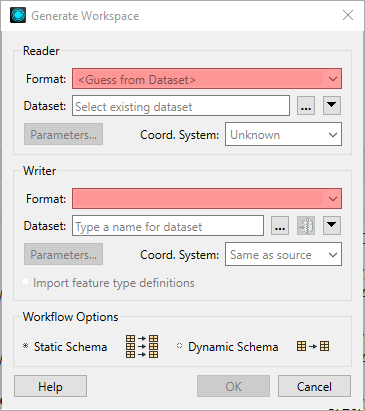FME Form: 2025.2
Using the Workspace Dialog
Location in FME Workbench:
Build > Generate workspace...

- Select Reader Format and Dataset
- Specify Reader Parameters
- Select Writer Format and Dataset
- Specify Writer Parameters
- Import Feature Types Definitions (for some database formats)
- Set Workflow Options
- Generate the new workspace file
Browse to the dataset file (or group of files) that you want to add. FME can usually determine the format from the file extension, and will automatically populate the Format field. These fields will already be filled in if you dragged a file directly onto the FME Workbench window.
If the Parameters button is enabled (and this depends on the format you choose), you can specify more detailed information about the reader data. Parameters are optional: if you don't edit them, FME will use default values. For detailed help, press the Help button or F1 key when you open a parameter box.
Select the format to which the data will be translated, and a name for the output file. To output data to a zip file, click the zip output icon.
If the Parameters button is enabled (and this depends on the format you choose), you can specify more detailed information about the reader data. Parameters are optional: if you don't edit them, FME will use default values. For detailed help, press the Help button or F1 key when you open a parameter box.
If you are writing to a database format, you can choose to import feature types with numerous attributes and properties from an existing writer. This eliminates this extra step after you create the workspace.
If, for example, you want to write to an existing Oracle table, you can check Import Feature Type definitions here and import the destination feature type with all of its attributes and data types defined exactly as they are in the existing Oracle table.
You can set workflow options before you create the workspace.

Static Schema is the default workflow, and is suitable for most workspaces. The schema is read from the source data and replicated on the workspace. Each reader feature type will be connected to its corresponding writer feature type.
Dynamic Schema breaks the dependence on the source and destination schema. One merged feature type will be connected to one writer feature type that is configured for dynamic operation. The schema is not replicated on the workspace; therefore, if the source data changes, you will not have to update the workspace – FME will do this automatically.
Read more about Dynamic Workspaces
Click OK. The translation log displays information related to workspace generation. Note that if you closed the translation log through the View > Window Layout menu, you can also see a subset of logging information in FME Workbench’s status bar.
Once you have created the initial workspace and it is displayed in the graphical view, you can either save the file in its current form, or adjust the data flows by adding transformers or new attributes.
To Understand Your New Workspace
- See Understanding Schema.